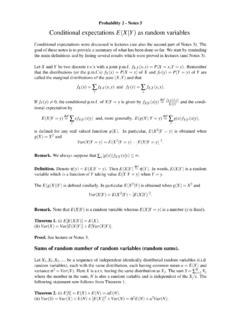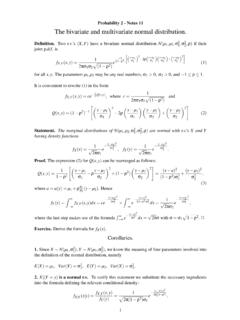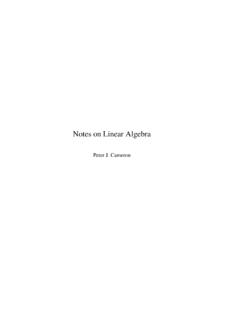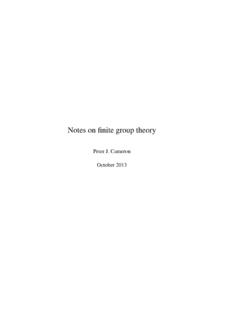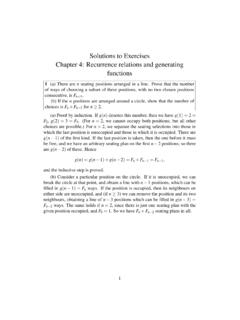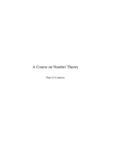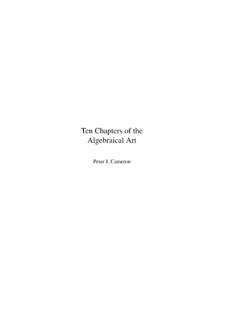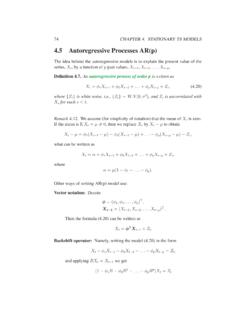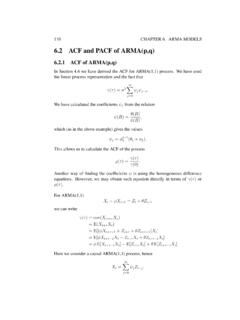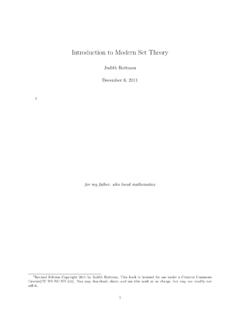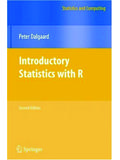Transcription of Notes on Combinatorics - QMUL Maths
1 Notes on CombinatoricsPeter J. CameroniiPreface: What is Combinatorics ? Combinatorics , the mathematics of patterns, .. , helps us design com-puter networks, crack security codes, or solve sudokusUrsula Martin, Vice-Principal (Science and Engineering),Queen Mary, University of LondonThese Notes accompanied the course MAS219, Combinatorics , at Queen Mary,University of London, in the Autumn semester is impossible to define Combinatorics , but an approximate description wouldgo like this. We are given the job of arranging certain objects or items accordingto a specified pattern. Some of the questions that arise include: Is the arrangement possible? In how many ways can the arrangement be made? How do we go about finding such an arrangement?This is best illustrated by 1: SudokuYou are given a 9 9 grid, divided into nine 3 3 job is to put the numbers 1,2,..,9 into the cells of the grid in such a waythat each number occurs just once in each row, once in each column, and once ineach 3 3 is not hard to see that the arrangement is indeed possible.
2 A heroic calcula-tion by Bertram Felgenhauer and Frazer Jarvis in 2005 showed that there are6,670,903,752,021,072,936,960differen t ways of filling the suppose that someone has complicated the problem by writing somenumbers into the grid already. In general it may or may not be possible to completethe grid; and even if it is, it may be very difficult to find a solution. Nevertheless,many people around the world enjoy engaging with this combinatorial problemevery 2: Euler s officersThe great mathematician Leonhard Euler asked in1782:iiiSix different regiments have six officers, each one holding a differentrank (of six different ranks altogether). Can these36officers be ar-ranged in a square formation so that each row and column containsone officer of each rank and one from each regiment?Euler conjectured that the answer is no , and this guess was eventually provedcorrect in 1900. However Euler also conjectured that the answer is no if six isreplaced by 10, 14, or any number congruent to 2 mod 4.
3 He was completelywrong about this, but this was not discovered until the 3: Kirkman s schoolgirlsIn 1843, Thomas Kirkman asked:Fifteen schoolgirls go for a walk every day for a week in five rows ofthree. Is it possible to arrange the walks so that every two girls walktogether exactly once during the week?This is certainly plausible. Each girl has to walk with fourteen others; everyday there are two other girls in her row, so seven days would be the right numberfor the schedule. However, this does not prove that the arrangement is fact, it can be done; Kirkman himself found a schedule satisfying the and realityThe examples may give you the impression that combi-natorics is a collection of charming puzzles of little relevance to our modern tech-nological world. In fact this is completely wrong. The course is not really aboutapplications, but in the digital world this subject is of enormous significance. Peo-ple (and computers!) spend a lot of time sorting data, sending messages throughnetworks, correcting faulty data or encoding data to keep it safe from unauthorisedaccess, designing better networks, looking for new combinations of atoms to formmolecules which will provide us with better drugs, and so on.
4 We need to decidewhen such a problem has a solution, and to find the solution notesThese Notes reflect the contents of the course in 2007. I have addeda couple of proofs of major theorems not covered in the course. The Notes havebeen provided with exercises (some of them with worked solutions) and an recommended textbook for the course was my own bookCombinatorics:Topics, Techniques, Algorithms, first published in 1994; but rather than followingthe book I have written everything anew. The course covers roughly the first halfof the book; if you enjoyed this, you may want to read more, or to look at myNotes on countingon the am grateful to Volkan Yildiz who spotted a number of misprints in a prelim-inary version of the readingEither of the two level 4 courses at Queen Mary can be takenby students who have done the Combinatorics course: MAS408: Graphs, Colourings and Design MAS439: Enumerative and Asymptotic CombinatoricsI mentioned above myNotes on countingwhich are on the web in the sameplace as these other books which contain further material (including the recommendedcourse text) are: Martin Aigner,Combinatorial Theory, Springer, 1979.
5 Norman Biggs,Discrete Mathematics(2nd edition), Oxford University Press,2002. Peter J. Cameron, Combinatorics : Topics, Techniques, Algorithms(2nd edi-tion), Cambridge University Press, 1996. J. H. van Lint and R. M. Wilson,A Course in Combinatorics , CambridgeUniversity Press, 1992. Jiri Matousek and Jaroslav Ne set ril,Invitation to Discrete Mathematics, Ox-ford University Press, Subsets and binomial .. of fixed size .. of binomial coefficients .. Binomial Theorem .. properties of binomial coefficients .. : Proof of Lucas Theorem .. 102 Selections and formulae .. in urns .. words from letters .. 183 Power series .. on power series .. Binomial Theorem .. power series .. 284 Recurrence numbers .. recurrences with constant coefficients .. recurrences with non-constant coefficients .. recurrences .. 415 Partitions and : Bell numbers .. : Stirling numbers.
6 : cycle decomposition .. : Stirling numbers .. 526 The Principle of Inclusion and .. and Stirling numbers .. 617 Families of s theorem .. families .. de Bruijn Erd os theorem .. fields and projective planes .. : Proof of the Erd os Ko Rado Theorem .. 728 Systems of distinct s Theorem .. many SDRs? .. 819 Latin by row .. squares .. Latin squares .. of mutually orthogonal Latin squares .. : Proof of Bose s Theorem .. 9110 Steiner triple Existence of STS(n).. Kirkman s schoolgirls .. Appendix: Proof of Kirkman s Theorem .. 101 Solutions to odd-numbered exercises107 Miscellaneous problems119 Index123 Chapter 1 Subsets and binomial coefficientsOne of the features of Combinatorics is that there are usually several differentways to prove something: typically, by a counting argument, or by analytic meth-ods. There are lots of examples below.
7 If two proofs are given, study them is about techniques as much as, or even more than, SubsetsLetnbe a non-negative integer, and letXbe a set withnelements. How manysubsets doesXhave?Proposition number of subsets of an n-element set proofWe encode subsets by sequences(e1,e2,..,en), where eacheiiseither 0 or 1. There are 2 choices fore1, 2 choices fore2, .. , 2 choices foren; soaltogether 2nsequences. So we are done if we can establish a bijection betweensubsets and each subsetYofX, we associate the sequence(e1,e2,..,en)whereei={1 ifi Y,0 ifi/ is easy to see that each sequence arises from a subset, and distinct sequencesarise from distinct subsets; so the correspondence is a proofThis is a proof by induction. Letf(n)be the number of subsetsof{1,2,..,n}. We see thatf(0)=1 (the empty set has just one subset, namelyitself). Also,f(n+1)=2f(n); for each subsetYof{1,2,..,n}can be extendedin two ways to a subset of{1,2.}}
8 ,n+1}: we can choose whether or not to12 CHAPTER 1. SUBSETS AND BINOMIAL COEFFICIENTS includen+1 in the subset. Now we can easily prove by induction thatf(n)= induction starts becausef(0)=1=20. For the inductive step, assume thatf(n)=2n; thenf(n+1)=2f(n)=2 2n=2n+ the induction goes through, and the proof is Subsets of fixed sizeIfnandkare integers satisfying 0 k n, how manyk-element subsets does ann-element setXhave?Define thebinomial coefficient(nk)by(nk)=n(n 1) (n k+1)k(k 1) 1.(There arekfactors in both the numerator and the denominator, thei-th factorsbeingn i+1 andk i+1.)For0 k n, the number of k-element subsets of an n-element set is(nk).ProofWe choosekdistinct elements of then-element setX. There arenchoicesfor the first element;n 1 choices for the second; ..n i+1 choices for thei-th;.. andn k+1 choices for thek-th. Multiply these numbers together to get thatthe total number of choices is the numerator of the fraction(nk).
9 This is not the answer, since choosing the same elements in a different orderwould give the same subset for example, 1, then 4, then 3 would be the same as3, then 1, then 4. So we have to divide by the number of different orders in whichwe could choose thekelements. There arekchoices for the first;k 1 for thesecond; ..k i+1 for thei-th; .. andk k+1=1 choice (really no choice atall!) for the last. Multiplying these numbers gives the denominator of the the result is will sometimes be convenient to give a meaning to the symbol(nk)even ifkis greater thann. We specify:Ifk>n, then(nk)= PROPERTIES OF BINOMIAL COEFFICIENTS3 This is a reasonable choice since, ifk>n, there are nok-element subsets of ann-element set. You should check that our formula for(nk)remains correct in thiscase: ifk>n, then one of the factors in the numerator is equal to Properties of binomial Sum of binomial coefficientsThe total number of subsets of ann-element set is 2n.
10 We know the number ofsubsets of sizek, for each value ofk: adding these up must give the total. In otherwords,n k=0(nk)= Binomial coefficients and factorialsHere is an alternative formula for the binomial coefficients. This uses thefactorialfunction, defined byn!=n(n 1)(n 2) 1,the product of all the integers from 1 toninclusive. Now we have(nk)=n!k!(n k)!.For if we take the definition of the binomial coefficient, and multiply top andbottom by(n k)!, then in the numerator we have the product of all the integersfrom 1 ton, that is,n!; the denominator isk!(n k)!.In order to make this formula valid in the limiting casesk=0 andk=n, wehave to adopt the convention that 0!=1. This may seem strange, but if we wantthe recurrencen!=n (n 1)! to hold forn=1, then it is forced upon us! Thisthen correctly gives(n0)=(nn)=1, and in particular(00)= , the formula does not work ifk>n, since thenn k<0 and wecannot define factorials of negative A recurrence relationThere is a simplerecurrence relationfor the binomial coefficients, which enablesbig ones to be calculated from smaller ones by addition:(n 1k 1)+(n 1k)=(nk).
